
Title means "Quietness", "Comfortable Sound" and "Excellent Acoustics"
Nagata Acoustics News 05-05 (No.209)
Issued : May 25, 2005
The Science, Uses and Advances in Perforated Panels - Part 1
by Dr. Keiji Oguchi
In Part 1 of this series of articles, I will discuss the gypsum board and plywood perforated panels used to build sound absorption systems. The most common perforated panels used in Japan have a thickness of 3 - 12 mm. (0.1 -0.5 in.) and round perforations of 4 - 13 mm. (0.2 - 0.5 in.) diameter. In addition, the ratio of perforations to board surface (perforation ratio) is 3 - 28%. In order to obtain effective sound absorption, a porous material such as glass wool is usually attached to the back of the perforated panels.
<< The Applicable Sound Absorption Principle >>
Section of Perforated Panel
Absorption System
(Helmholtz Resonator)
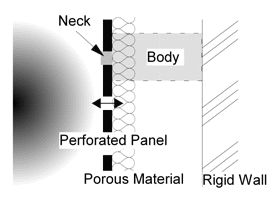 |
When perforated panels are used as part of a sound absorption system, the system is assumed to be an array of Helmholtz Resonators, the columns of air in each perforation correspond to the "neck" of the Resonator and the layer of air at the back side of the panel including glass wool to the "body" of the Resonator.As sound passes through a perforation, it causes the air of "neck" to vibrate. When the vibrations meet the resistance of the panel material surrounding the perforation or the resistance of the glass wool attached to the back of the perforated panel, the resistance causes the sound to convert to heat energy, resulting in the sound being absorbed. For a Helmholtz Resonator, the air of "neck" is the mass and the air of "body" acts as the spring that moves, generating a resonance (resonant vibration) of a specific frequency. Because the column of air vibrates the most vigorously at and near the resonant frequency, the result is that the resonator most effectively absorbs sound of this frequency.
<< Sound Absorption Characteristics >>
Absorption Characteristics of
Perforated Panel Absorption System
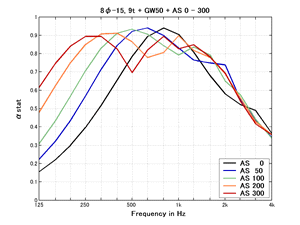 |
The sound absorption characteristics of perforated panel sound absorption systems demonstrate a bell-shaped sound absorption characteristic centered on the resonant frequency. For frequencies near the resonant frequency, friction in the vicinity of the perforation results in some sound absorption (up to a maximum of 50% absorption). When a layer of porous material is inserted behind the perforated panels, the resistance increases and the level of sound absorption approaches 100%.
By changing the thickness of the perforated panel, the ratio of perforations to solid panel and/or the thickness of the air layer behind the perforated panel, it becomes possible to realize sound absorption of specifically low, mid-range or high frequencies, or absorption of a broad range of frequencies. In a research study Mr. Hiromi Suga collected approx. 1,100 data on sound absorption from a variety of published sources several years ago, 350 data of 1,100 show perforated panel sound absorbing systems.With this wealth of available data on perforated panel sound absorbing systems, it is no wonder that they are widely implemented both in halls and in nearly every other structure and environment requiring sound absorbing elements.
<< Perforated Panels Used in Auditoria and Rehearsal Rooms >>
Perforated panel sound absorption systems have many applications. In the design of auditoria and rehearsal rooms, the most often used perforated panel sound absorption systems are designed to absorb a broad spectrum of sound frequencies. The specifications for these systems include a perforation ratio equal to or greater than 20%, a porous material backing (such as glass wool or rock wool), and an air layer with a thickness equal to or greater than 300 mm. (12 in.). The absorption mechanism of these panels is a combination of (1) the perforated panels and a thick air layer backing acting together as a Helmholtz Resonator to absorb sound in mid-range and low frequencies; and, in addition, (2) the existence of multiple air column resonances in the air layer that absorb sound in the mid-range and high frequencies.
<< Perforated Panel Examples >>
In concluding this article, I will introduce the reader to some examples of common and more innovative perforation panels. Photo A shows the most common kind of perforation panel, with round holes drilled in the panel. Photo B shows a perforated panel with square holes punched through the panel. Photo C is an example of random perforations created using laser technology and photo D shows a ceiling with a pattern of slit-hole perforations. In Japan, these and other perforated panel design options have become increasingly easy to obtain, creating greater design freedom for rooms that require perforated panel sound absorbing systems.
A. Round Hole Perforated Panel (PP)
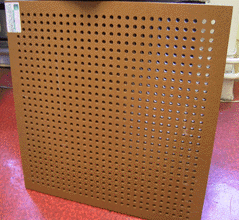 |
|
| | | |
B. Square Hole PP
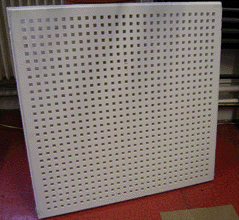 |
|
C. Random Hole PP
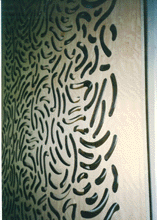 |
|
| | | | | | | |
D. Ceiling with Slit Hole PP
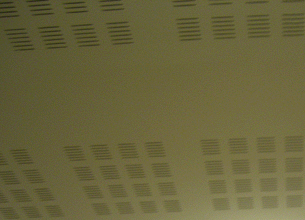 |
|
>> In the next article on this topic, I will discuss microperforated panel absorbers.
St. Petersburg's New Mariinsky Theatre Concert Hall
by Yasuhisa Toyota
Section of Mariinsky3
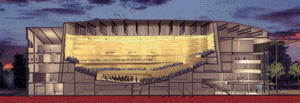 |
Readers may recall my February, 2005 article about Nagata Acoustics design of the acoustics for the new Mariinsky Theatre Opera House in St. Petersburg, Russia. (In some countries outside Russia, the Mariinsky Theatre is still often known by its former name of Kirov Opera.) The new opera house project continues to make good progress and a companion concert hall project will now also be built on a nearby site. Observers and participants in the projects refer to the new opera house as Mariinsky 2 and the new concert hall as Mariinsky 3 to distinguish them from the existing Mariinsky Theatre Opera House building.
<< A New Concert Hall from a Warehouses Ashes >>
In September 2003, the Mariinsky Theatre's warehouse building for stage sets and costumes, located a few city blocks from the current theatre, suffered a devastating fire that resulted in big loss of the opera company's sets and costumes. Initially, the opera company's sudden loss of its sets, props and costumes created a performance obstacle requiring great effort, creativity and a flurry of activity in order to overcome and ensure that the opera company's foreign engagements and home performances could be staged as scheduled.
Artistic Director Valery Gergiev quickly found a way to give a silver lining to this tragedy by proposing that the land where the warehouse building had stood be used as the site for construction of a new concert hall. The outer structure of the building warehouse was fortunately remained and this was planned to be used as a part of the new hall's building. Fortunately, the size and shape of the warehouse site is well-suited for a medium-size, shoebox configuration concert hall. Artistic Director Gergiev wasted no time in approaching the governor about his proposal and requesting funding for this new project. The governor accepted Mr. Gergiev's proposal.
<< Innovative Design Elements Enhance a Shoebox Configuration >>
While we based the Mariinsky Theatre Concert Hall room acoustical design on a traditional shoebox configuration, we deviated from a traditional shoebox design by adding audience seating around the stage and a noticeable slope to the audience seating area of the hall's main floor. Thus, compared with the historical famous shoebox-shape concert halls such as Vienna, Boston etc., the Mariinsky Theatre Concert Hall's shoebox will have some unique design elements.
<< Project Participants and Fast-tracked Schedule >>
The Parisian firm of Fabre, Speller, Pumain is the architect for the Mariinsky Theatre Concert Hall. Nagata Acoustics is the acoustical consultant for this project, in addition to serving in this capacity on the new Mariinsky Theatre Opera House project. At present, the design is nearly complete and the next phase of construction will overlap the production of construction documents and shop drawings with actual construction.
Our client, the Mariinsky Theatre, aims to open the new concert hall within the next year, 2006. This goal requires that the project follow a very aggressive schedule, and we are working with speed and dedication to support meeting the Mariinsky Theatres desired opening date.
E-mail Distribution of Nagata Acoustics News & Opinions
We hope you have enjoyed this News & Opinions newsletter, available each month on our web-site (http://www.nagata.co.jp). We also offer e-mail delivery of the text version of this newsletter. To receive the text newsletter to your e-mail address, simply send the following information to us at newsmail_e@nagata.co.jp:
(1) Your e-mail address
(2) Your name
(3) The name of your company
By requesting the text version via e-mail, you will automatically receive every newsletter and you can still get the visuals and graphics at our web-site.
Nagata Acoustics News 05-05 (No.209)
Issued : May 25, 2005
Nagata Acoustics Inc.
Hongo Segawa Bldg. 3F, 2-35-10
Hongo, Bunkyo-ku, Tokyo 113-0033 Japan
Tel: +81-3-5800-2671, Fax: +81-3-5800-2672
(US Office)
1610 Broadway, Suite A
Santa Monica, CA 90404, U.S.A.
Tel & Fax: 310-526-0329
E-mail: info@nagata.co.jp





